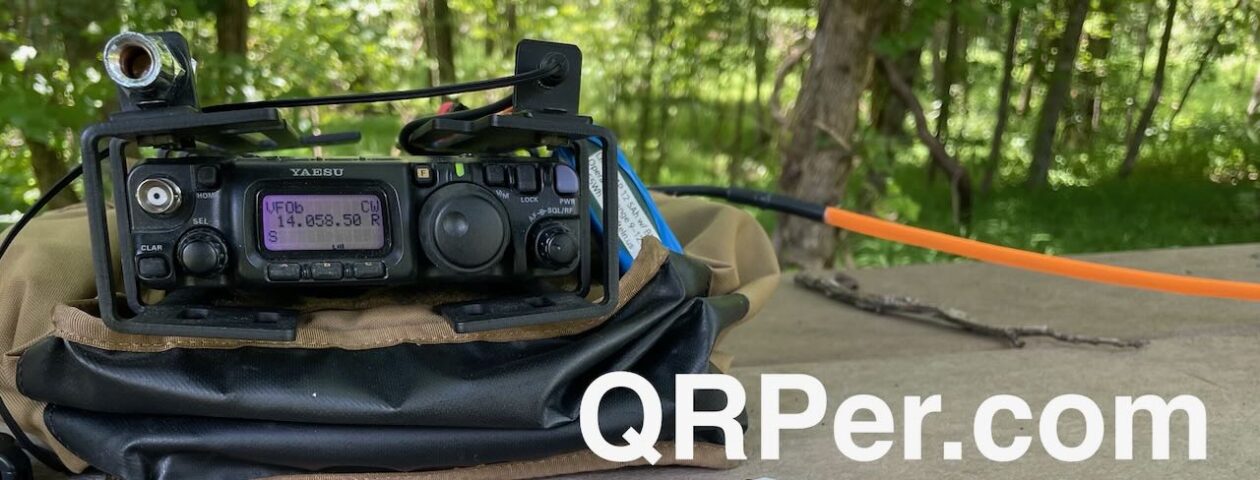Many thanks to Bob (K7ZB) who shares the following guest post:
QRP Operation with the QRP Labs QCX+ and ATU-100 on 20M CW
Bob Houf (K7ZB)
By now the QRP Labs QCX+ CW transceiver is well known, and many have been shipped by Hans.
The first unit I bought came fully assembled in the aluminum case but had a weird malfunction in the audio chain and after careful troubleshooting with Hans’ help a replacement unit was sent and worked well.
I have assembled plenty of electronics kits in 60 years of ham radio, building some from scratch and worked as an electronics design engineer for years so having someone else solder up a board now is a luxury I am happy to pay for – but if you like the smell of solder as smoke gets in your eyes and your hands don’t shake, by all means save some money and build one yourself.
I picked up a Malahit rendition of the N7DDC ATU – mine came from Amazon and is the 100W version that uses an external power supply.
My first setup was to see if I could power both the QCX+ and ATU-100 simultaneously from a portable 25800mAH charger bank with two USB ports. The addition of two USB-to-12VDC converter cables looked like an ideal way to minimize the size of the radio package for portable operation:
Unfortunately, although the power capability of the battery was far more than adequate, when transmitting CW for just a few seconds the battery BMS tripped the power unit offline.
So, my next move was to use my larger 12V, 6AH LiFePo4 battery to power both units which worked well.
 The antenna used here is a longwire of 47’ running from the top of our second-floor balcony out to a tree. The wire is about 25’ above ground and runs between two of the 3-unit townhouse/loft condo building units. There seems to be little interaction noticed on the signal reports received due to the physical proximity. And, when not experimenting with QRP I routinely run 100W from my transceiver into the wire without a problem.
The antenna used here is a longwire of 47’ running from the top of our second-floor balcony out to a tree. The wire is about 25’ above ground and runs between two of the 3-unit townhouse/loft condo building units. There seems to be little interaction noticed on the signal reports received due to the physical proximity. And, when not experimenting with QRP I routinely run 100W from my transceiver into the wire without a problem.
This time, however, I decided to use #26-gauge magnet wire instead of the far stealthier #28 wire I have run for the past year. A tree trimming gang went through earlier in the summer and took out my #28 monofilament tether line in the tree, so I decided to go with a larger diameter wire.
In both cases I sponge a thin layer of battleship gray paint on the line which helps conceal it when looking up in the sky.
One discovery from this version is that there is a BIG difference in visibility between #26 and #28 magnet wire as seen from the ground!
I took down the #26 and will revert to #28 – which is essentially invisible at 25’ above your head.
I run the wire directly into a Common Mode Choke which then drops down to another CMC designed for other bands so that with the two in series I have no shield currents and no circuit breaker tripping or RF in the shack issues on 40, 20, 15 and 10M, even running 100 Watts:
 I have a very low noise level on receive and don’t use a Balun at the feedpoint of the antenna, but I do use an antenna tuner to match the impedance, either the built-in tuner of my Kenwood transceiver or the ATU-100 for the QRP rig.
I have a very low noise level on receive and don’t use a Balun at the feedpoint of the antenna, but I do use an antenna tuner to match the impedance, either the built-in tuner of my Kenwood transceiver or the ATU-100 for the QRP rig.
The CMC’s were designed by a friend using the K9YC cookbook approach available online and are very effective.
QCX Operation
The band conditions over the past weekend were funky with high noise level and rapid fading at times.
Despite this, I made multiple contacts in the western USA with reasonable signal reports and only one station had to send “sri no cpi”.
On Sunday evening I stumbled into the K1USN Slow Speed Contest (SST) and enjoyed making contacts from the Midwest to the Pacific Northwest and everywhere in between.
Band conditions were much quieter and there were signals nearly every kilohertz from about 14.030 up to around 14.050+.
The QCX+ uses a CW filter design set at 200Hz and with 10Hz frequency resolution it was easy to copy one signal from another, despite the lack of more sophisticated filtering capability.
Since you only are putting out a 4-Watt signal you search and pounce with care and in a casual contest like the SST it makes for a very enjoyable way to spend an hour on Sunday evening before the SNF game steals you away.
Or a World Series game.
The ATU-100 was delightful to use. Once it tuned to a decent match (1.33:1) on the wire, it was good for the entire span from the bottom of the band up to 14.060 where the POTA gang and other low power stations hang out.
In conclusion, this is a very excellent low power station, simple to use and I am looking forward to matching it with a clever 20M elevated vertical with elevated radials a fellow ham has designed:

Once that is working, it is off to the Lost Dutchman State Park for some POTA fun…







